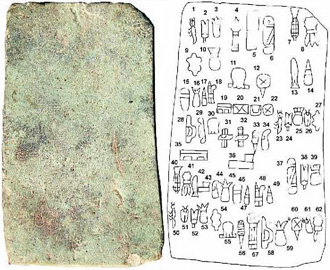 |
 |
 |
 Entertainment | Books | October 2006 Entertainment | Books | October 2006  
Reading into the Past
 Patricia Chargot - Detriot Free Press Patricia Chargot - Detriot Free Press


| The Symbols

Scientists who have seen the Olmec slab believe it is writing. The symbols are organized horizontally, which is unusual in ancient Mexican writing. "And certain symbols are repeated, as though they had the same meaning," said Richard Diehl. "But we have no real clues to what it might say. One suggestion is that it might talk about the tribute, or tax, paid to a king or to the government." |
What is the oldest writing in the Americas? It's a string of 62 symbols, or little pictures, carved into a stone slab that looks like a Flintstone laptop computer. Scientists say it's almost 3,000 years old - 1,000 years older than what until recently was the oldest example of New World writing.

"We know it's not a fake," said Richard Diehl, an anthropologist, or scientist who studies human cultures.

"We've had geologists examine it. And a patina, or microscopic coat, covers both the inscriptions and the stone from being covered in soil for such a long time."

Richard and a team of three other U.S. scientists traveled to Mexico this spring to examine the slab and take photographs. They and two Mexican archeologists later collaborated on an article, which appeared in the September issue of Science magazine.

The slab was found in a gravel pit near San Andres Tuxtla, a city in the Mexican State of Veracruz about 35 miles from the Gulf of Mexico. (The site is only about 100 miles from the Los Tuxtlas Biological Station in the country's tropical rain forest, which the Yak visited and wrote about in 1999.)

"The men who owned the property were digging gravel for road fill," said Richard, a professor at the University of Alabama.

"The place where they were digging was an archeological site. But it's not protected. They just threw it aside until they realized what it was."

But the slab turned out to be more than just another ancient artifact, thousands of which have been unearthed in Mexico. It was the first evidence that the Olmecs, the oldest civilization in the Americas, could read and write.

"They're the mother culture of the Americas," Richard said. "The Olmecs were the first complex society after hunters and gatherers."

For at least 9,000 years before Olmec (OHL-mec) culture appeared, small bands of people hunted, fished and gathered wild foods in the Americas. The first bands came from Asia, crossing the land bridge that once existed across the Bering Sea, linking Siberia and Alaska.

About 3,500 years ago, the Olmecs began building cities along the eastern Mexican coast. Olmec culture spread as far as what today is El Salvador, dotting the jungle landscape with stone buildings, earth pyramids and huge sculptures of human heads.

No one yet knows what the Olmec slab says.

"You can't decode it," Richard said. "You really need more than one example so you can look for patterns. Sometimes even if you have a lot, you still can't do it."

Some of the symbols look like plants or animals. Others are more abstract, hard to guess at. One looks like a cross, which "is very common in Olmec and other pre-Columbian art and depicts the four directions," Richard said. (Pre-Columbian art dates to the time before Christopher Columbus landed in the Americas.)

Another symbol looks like an ice cream cone!

Could Olmec kids read the slab?

"Probably not," Richard said. "Probably only powerful people learned to read, possibly men and women both."

By 400 B.C., Olmec culture had vanished. The cities were abandoned for reasons that are still a mystery. The Olmecs moved around, established new villages and even changed their style of art.

"They really weren't Olmecs anymore," Richard said. "But the people are still there, their descendents still exist. If you walk around San Andres Tuxtla, there are people all over that area that look like Olmecs." | 
 | |
 |



